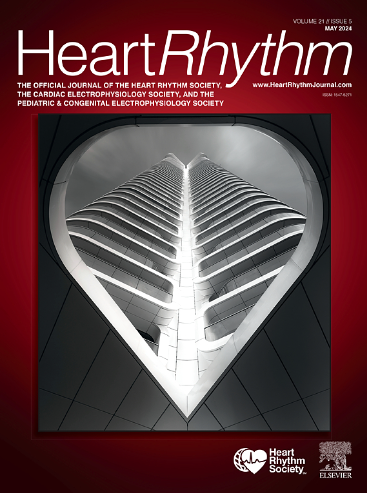左心房阑尾排空速度的预测因素:CHIRP3(M-1)评分的推导与验证。
IF 5.6
2区 医学
Q1 CARDIAC & CARDIOVASCULAR SYSTEMS
引用次数: 0
摘要
背景:心房颤动(房颤)会导致左心房阑尾收缩功能受损,从而增加血栓栓塞性卒中的风险。经食道超声心动图(TEE)测量的左心房阑尾排空速度(LAAev)是血栓栓塞风险增加的标志:评估 LAAev 降低的预测因素,以识别心源性中风风险增加的个体:这是一项对 TEE 和临床病历进行的单中心回顾性研究。LAAev 的预测因素我们纳入了 995 例患者的 TEE(年龄 71.3±12.7 岁,女性 38.1%,房颤史 82.1%,评估时房颤 27.7%,CHA2DS2-VASc 评分 4.1±1.9,LAAev 41.6±21.0cm/s)。LAAev 3M-1 评分的重要多变量预测因子包含 8 个变量:冠状动脉疾病(1)、充血性心力衰竭(1)、左心房容积指数增大≥42 mL/m2 (1)、当前节律性房颤(1)、阵发性房颤(2)、持续性房颤(3)、长期持续/永久性房颤(4)和>中度二尖瓣反流(-1)。在验证组中,与中间评分(3-4 分)相比,低分(≤2 分)和高分(≥5 分)者发生 LAAev 的几率比较大:我们开发并验证了一种新型风险分层系统,该系统利用临床和超声心动图变量预测 LAAev 的减少。这可能有助于完善心源性卒中风险分层。本文章由计算机程序翻译,如有差异,请以英文原文为准。

Predictors of left atrial appendage emptying velocity: Derivation and validation of CHIRP3(M-1) score
Background
Atrial fibrillation (AF) leads to impaired left atrial appendage contractility, increasing the risk of thromboembolic stroke. The left atrial appendage emptying velocity (LAAev) measured on transesophageal echocardiogram (TEE) is a marker of increased thromboembolic risk.
Objectives
The purpose of this study was to evaluate predictors of reduced LAAev for identifying individuals at increased risk for cardioembolic stroke.
Methods
This was a single-center retrospective review of TEEs and clinical charts. Predictors of LAAev <30 cm/s were identified using logistic regression. A risk prediction model was created using stepwise selection in a derivation set (n = 695) and separately tested in a validated set (n = 300).
Results
We included TEEs on 995 patients (age 71.3±12.7 years; female 38.1%; history of AF 82.1%; in AF at evaluation 27.7%; CHA2DS2-VASc score 4.1 ± 1.9; LAAev 41.6 ± 21.0 cm/s). Significant multivariable predictors of LAAev <30 cm/s in derivation set were used to create the CHIRP3M-1 score containing 8 variables: Coronary artery disease (1), congestive Heart failure (1), Increased left atrial volume index ≥42 mL/m2 (1), current Rhythm AF (1), Paroxysmal AF (2), Persistent AF (3), longstanding Persistent/permanent AF (4), and greater than moderate Mitral regurgitation (-1). In the validation set, as compared to intermediate scores (3–4), those with low scores (≤2) and high scores (≥5) had odds ratios for LAAev <30 cm/s of 0.41 (0.21, 0.78, P = .007) and 2.58 (95% confidence interval 1.45–4.61, P = .001), respectively.
Conclusion
We developed and validated a novel risk stratification system to predict reduced LAAev using clinical and echocardiographic variables. This may help refine the stratification of cardioembolic stroke risk.
求助全文
通过发布文献求助,成功后即可免费获取论文全文。
去求助
来源期刊

Heart rhythm
医学-心血管系统
CiteScore
10.50
自引率
5.50%
发文量
1465
审稿时长
24 days
期刊介绍:
HeartRhythm, the official Journal of the Heart Rhythm Society and the Cardiac Electrophysiology Society, is a unique journal for fundamental discovery and clinical applicability.
HeartRhythm integrates the entire cardiac electrophysiology (EP) community from basic and clinical academic researchers, private practitioners, engineers, allied professionals, industry, and trainees, all of whom are vital and interdependent members of our EP community.
The Heart Rhythm Society is the international leader in science, education, and advocacy for cardiac arrhythmia professionals and patients, and the primary information resource on heart rhythm disorders. Its mission is to improve the care of patients by promoting research, education, and optimal health care policies and standards.
 求助内容:
求助内容: 应助结果提醒方式:
应助结果提醒方式:


